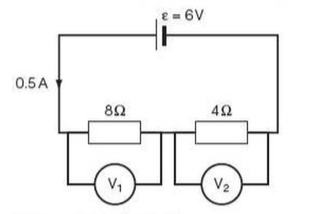Potential Difference and Electromotive Force
Summary
⇒ Electric current only measures the rate at which charged particles (usually electrons) flow around a circuit
- It tells us nothing about the electrical energy involved with circuits
⇒ The quantity used to describe the electrical energy in circuits is potential difference (pd), symbol V, measured in volts, V
⇒ A potential difference across an electrical component is measured by putting a voltmeter across the component, in parallel with it
Potential Difference
⇒ Electrical energy in circuits is defined in terms of the electrical work done by the electrical charge flowing through the circuit
⇒ Potential difference is defined as the electrical work done per unit (coulomb) of charge flowing through components such as bulbs, motors, resistors, etc.
⇒ This electrical energy is ransferred into heat, light, and other more useful forms of energy by the components

Electromotive Force
⇒ Potential difference, however, cannot be used to describe the energy changes involved with power supplies such as cells, generators and mains power supply units
- These devices transfer other forms of energy, such as chemical energy into electrical energy
⇒ To make a distinction between these different energy transfers we define another quantity, electromotive force (emf), symbol ε
⇒ Both emf and pd are measured in volts, symbol V, using a voltmeter
⇒ Electromotive force is defined as the electric work done per unit (coulomb) of charge as it flows through a source of electrical energy such as a cell, generator or power supply unit (psu)
- The sources of electrical energy transfer other forms of energy such as kinetic or light energy into electrical energy
⇒ The law of conservation of energy can now be written in terms of emf and pd
- In a series circuit, where the components are connected one after another in a complete loop, the total electrical energy per coulomb transferring into the circuit (the sum of the emfs in the circuit) must equal the energy per coulomb transferring into other forms of energy (the sum of the pds)
- Here is an example. The following circuit is set up:

⇒ The emf of the cell, ε, transfers 6JC-1 (V) of chemical energy into electrical energy (if the cell is 100% efficient)
⇒ The 6JC-1 of electrical energy is shared between the two resistors
- This energy is shared in the same ratio as the resistance of the resistors (8:4 or 2:1)
- The potential difference, V1, across the 8Ω resistor is therefore 4JC-1 (V) and the potential difference, V2, across the 4Ω resistor is therefore 2JC-1 (V)
⇒ Note that the law of conservation of energy still holds here as 6JC-1 (V) is transferred from chemical energy into electrical energy in the cell and 6JC-1 (V) in total is transferred from electrical energy into heat energy within the resistors